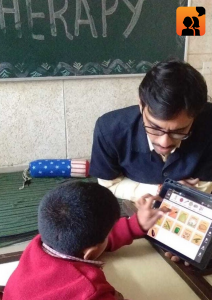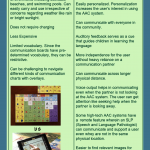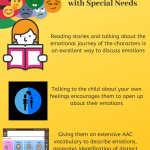A Comprehensive Look at Echolalia Definition, Types, and Purposes
Echolalia is common among people with autism spectrum disorder (ASD). Emerging studies have questioned the long-held belief that echolalia maybe a behaviour with no purpose. Read on to learn about echolalia definition, the different types and the corresponding speech patterns.
Echolalia in Autism
An individual with echolalia repeats or imitates words or phrases they hear. Verbal repetition is seen in all young children as they begin to communicate. In fact, it is a vital part of their language learning and development. But, as they grow older, children generally start expressing their own thoughts through their words, in addition to verbal imitation. Children with ASD, on the other hand, tend to have echolalia longer than typical children.
Echolalia used to be dismissed as a behaviour with no communicative intent. But, recent studies have shown that it may be a part of the child’s attempt to have a meaningful exchange. A growing number of experts reiterate the need to understand a child’s echolalia. They believe that parents, teachers, therapists and other caregivers should attempt to figure out what the child is trying to communicate through verbal repetition.
What is Echolalia
Children with ASD can learn language as phrases or a string of words, and associate them with situations. They may do so without understanding the meaning of individual words. This may lead them to utter phrases that might seem out of place. But on careful observation, you may be able to understand the communicative intent behind their random utterances.
For example, the child may say, “Is this your sister?”, while meaning to say “This is my sister.”
Similarly, the child may utter phrases from movies or TV shows they have been watching. For instance, the child may say, “Okay,bye” when they did not get to play with their favourite toy. This might seem irrelevant to those who are unfamiliar with the TV show or movie. But that may be the child’s way of expressing their disappointment, because a character in a movie they watched used the exact phrase to convey their disappointment.
Repeating words right after hearing them is known as immediate echolalia. Repeating words at a later time is known as delayed echolalia. Delayed echolalia may be harder to comprehend by others, because people might not be able to make the connection to the phrases, words, or sentences uttered, due to the delay.
Interactive Echolalia and Non-interactive Echolalia
Delayed echolalia is categorised into interactive echolalia and non-interactive echolalia. Interactive echolalia, also called functional echolalia, is an effort to communicate with another individual. Non-interactive echolalia maybe for personal use and generally lacks communicative intent.
You may be unable to ascertain if the echolalia is interactive or non interactive unless you are familiar with the individual. Since echolalia may involve information referenced from the individual’s personal life, a stranger might not be able to deduce the connection and identify interactive echolalia.
Purposes of Interactive Echolalia
Here are some of the ways and purposes for which interactive echolalia may manifest. This may help you identify similar cues in your child, or those you work with.
Requesting
The child may say “Would you like a sandwich?” around lunchtime. It might look like the child is just repeating what they heard earlier. But that may be the child’s way of requesting a sandwich.
Initiating Interaction
The child may say, “Ahh..This chair is just right” if they wanted someone to read them the story of ‘Goldilock and the three bears’.
Showing Approval or Disapproval
The child may say, “Don’t you want to play now?” instead of saying, “I don’t want to play now’. Similarly, if the child is asked, “Did you like the movie?”, they may repeat the question to say that they liked the movie.
Giving information:
A child may sing, ‘Hush little baby’ to say that they want to go to sleep. A parent may be able to make the connection because they sing it to the child while putting them to bed.
Seeking Attention
The child might repeat any gibberish or phrases that drew the attention of their parents or teachers earlier, to get their attention again.
Purposes of Non-interactive Echolalia
Non-interactive echolalia may not have a communicative intent. But it is important to the child in their process of making sense of the world around them. Here are some ways in which children may use this.
Non-focussed
The child sings a song or repeats dialogues from a movie they watched earlier. These utterances are generally not intended for communication and maybe for self-stimulation.
Situation association:
The child’s utterances might be because an object, event, or a person caught their attention. For example, when they see an apple in the local supermarket, they may sing a song from the apple juice TV commercial.
Rehearsal:
The child may repeatedly whisper a phrase to themselves before uttering the same in a normal voice. This may be a way of preparing themselves for the upcoming interaction.
Self-direction:
The child may instruct themselves as they perform an activity. For example, if the child wants to put away the toys, they might say, “Pick up the truck, then pick up the car, put them in the toy box.”
Labelling
The child may point out to random objects or actions and label them repeatedly. For example, the child may notice a fruit and repeatedly say, “Fruits. Fruits are healthy.” The child may do so without intending to request a fruit. This may be the child’s way of using words to learn language.
 Echolalia Intervention
Echolalia Intervention
The child’s use of echolalia may be because they do not know the correct response. Training them to say, “I don’t know” can help in them using the phrase when they do not know the answer to a question. Another approach is to teach them the appropriate response. For example, you can ask, “How are you doing?”, and say, “I’m fine.” immediately. This will help the child understand the correct response to the question.
AAC (Augmentative and Alternative Communication) solutions such as AAC apps can be useful in augmenting the language of verbal communicators and help mitigate echolalia. The app can help them break down phrases into meaningful words and enable them to develop language that reflects their thoughts. AAC strategies can also help them learn new words and understand their meaning. With consistent AAC use, children can learn to use language for autonomous communication instead of giving scripted responses.
Children who repeat words without understanding their meaning can go on to alter the same phrases, indicating comprehension. They may also use more flexible language, suggesting independent thought. Though the child may occasionally use echolalia for self-stimulation when distressed or exhausted, they might begin to use phrases and sentences appropriately as they begin to understand language better. Echolalia can therefore be looked at as a positive step in language development, rather than a purposeless habit.
Get free Language Builder Resources here
Hope you find this post on echolalia definition and purposes useful. Please share your ideas on echolalia in autism in the comment section below.
Subscribe to the Avaz Newsletter
Join 4000+ fellow readers! Get latest articles straight to your inbox. Enter your email address below:
Popular Articles
- Building Literacy: Teaching Grammar to AAC Users
- Expansion of Language: Supporting AAC Learner’s Progress
- Avaz User Stories and Videos
- Avaz Joyful Reading: Resources for Shared Reading
- AAC Resources: Games, Activities and Communication Opportunities
- Avaz AAC User Stories: Why Nishant and his AAC System are Inseparable
- Downloadable Low Tech Communication Boards
- Get the Better of Reading Difficulties with MDA Avaz Reader
- AAC Apps for Adults with Acquired Communication Disorders
- Teletherapy: A smart way to facilitate remote speech therapy for adults and children


What is the source of this article?
Here are some of the sites referenced for the article:
http://www.hanen.org/Helpful-Info/Articles/3-Things-You-Should-Know-About-Echolalia.aspx
http://www.autism-help.org/communication-echolalia-autism.htm
https://www.healthline.com/health/echolalia#outlook-and-prevention
According to me, Echolalia has always been a positive strength in communication as it shows that child has the auditory attention to the words and able to repeat them . Also it also means that he/she has memory and immediate recall of those x-number of words spoken. Yes, he may not be using language meaningfully but may have a communicative intent. The article is very clear in explaining all types of echolalia and its purpose.
Thanks for the lovely comments. We are happy that you found this article useful.
Beautiful article. Thanks to whoever wrote it. Very helpful for understanding my sons current condition. I talk to him by using verses from movies. If someone heard us they’d think we are being silly reviewing the movie, but our conversation has meaning,
Glad you like the article. Definitely, a child can be supported better if we have a deeper understanding of their behaviours and the underlying causes.